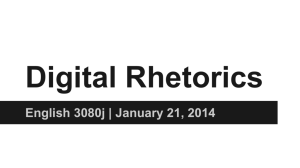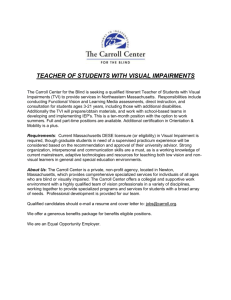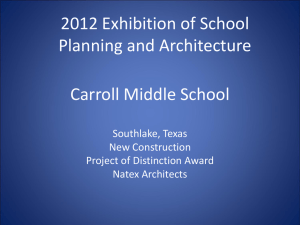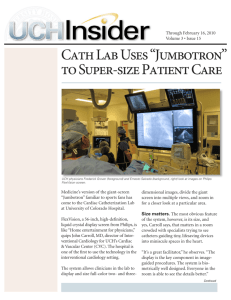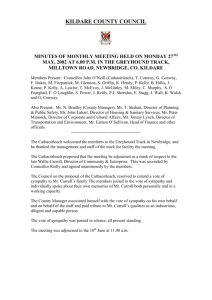Department Conceptual Framework
advertisement
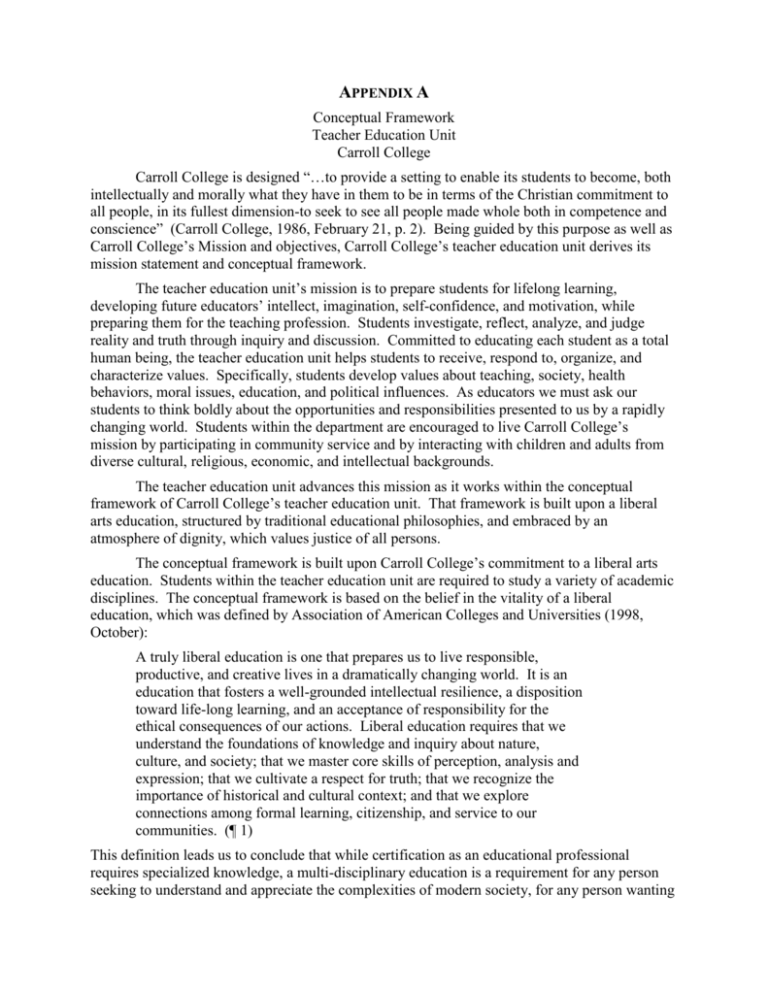
APPENDIX A Conceptual Framework Teacher Education Unit Carroll College Carroll College is designed “…to provide a setting to enable its students to become, both intellectually and morally what they have in them to be in terms of the Christian commitment to all people, in its fullest dimension-to seek to see all people made whole both in competence and conscience” (Carroll College, 1986, February 21, p. 2). Being guided by this purpose as well as Carroll College’s Mission and objectives, Carroll College’s teacher education unit derives its mission statement and conceptual framework. The teacher education unit’s mission is to prepare students for lifelong learning, developing future educators’ intellect, imagination, self-confidence, and motivation, while preparing them for the teaching profession. Students investigate, reflect, analyze, and judge reality and truth through inquiry and discussion. Committed to educating each student as a total human being, the teacher education unit helps students to receive, respond to, organize, and characterize values. Specifically, students develop values about teaching, society, health behaviors, moral issues, education, and political influences. As educators we must ask our students to think boldly about the opportunities and responsibilities presented to us by a rapidly changing world. Students within the department are encouraged to live Carroll College’s mission by participating in community service and by interacting with children and adults from diverse cultural, religious, economic, and intellectual backgrounds. The teacher education unit advances this mission as it works within the conceptual framework of Carroll College’s teacher education unit. That framework is built upon a liberal arts education, structured by traditional educational philosophies, and embraced by an atmosphere of dignity, which values justice of all persons. The conceptual framework is built upon Carroll College’s commitment to a liberal arts education. Students within the teacher education unit are required to study a variety of academic disciplines. The conceptual framework is based on the belief in the vitality of a liberal education, which was defined by Association of American Colleges and Universities (1998, October): A truly liberal education is one that prepares us to live responsible, productive, and creative lives in a dramatically changing world. It is an education that fosters a well-grounded intellectual resilience, a disposition toward life-long learning, and an acceptance of responsibility for the ethical consequences of our actions. Liberal education requires that we understand the foundations of knowledge and inquiry about nature, culture, and society; that we master core skills of perception, analysis and expression; that we cultivate a respect for truth; that we recognize the importance of historical and cultural context; and that we explore connections among formal learning, citizenship, and service to our communities. (¶ 1) This definition leads us to conclude that while certification as an educational professional requires specialized knowledge, a multi-disciplinary education is a requirement for any person seeking to understand and appreciate the complexities of modern society, for any person wanting to be a responsible, world citizen, capable of making wise decisions and acting appropriately within a democratic society. Because educators are teachers of students while they are teachers of subjects, all educators benefit from a liberal education, because it takes the perspectives of numerous disciplines to begin to appreciate and respond to the complexity and diversity encountered by teachers. In the words of Cardinal Newman (1947), education gives students “…a clear, conscious view of their own opinions and judgments, a truth in developing them, an eloquence in expressing them and a force in urging them” (p. 157). We also take seriously our responsibility to produce effective citizens. Our commitment to preparing our students to meet the needs of a diverse K-12 student body and a continually changing future is supported by the liberal arts education they receive at Carroll College. We are continually reminded that, as Piaget (1971) wrote, “The current state of knowledge is a moment in history, changing just as rapidly as knowledge in the past has changed, and, in many instances, more rapidly” (p. 1). Because a liberal arts education utilizes a myriad of experiences and the many ways of knowing within its boundaries, a commitment to this approach necessitates a concomitant dedication to life-long learning. We join Thomas Jefferson (as cited in Padover, 1943) in articulating that the purpose of a true education is: …to develop the reasoning faculties of our youth, enlarge their minds, cultivate their morals, and instill into them the precepts of virtue and order; to enlighten them with mathematical and physical sciences, which advance the arts and administer to the health, the subsistence and comforts of human life; and, generally, to form them to habits of reflection and correct action; rendering them examples of virtue to others and of happiness within themselves. These are the objects of that higher grade of education… (p. 1098) While the department’s conceptual framework is based upon a liberal arts foundation, its structure is defined by its faculty members’ conviction that at any level, pre-school to graduate school, students are not solely educated through the one-way transaction of receiving information from their instructors. As Brooks and Brooks (1993) wrote, “We construct our own understandings of the world in which we live. We search for tools to help us understand our experiences” (p. 4). Students must intelligently act upon information; information, then, becomes knowledge, and learning becomes transformative education. Indeed, as Bruner (1996) pointed out: To instruct someone…is not a matter of getting him to commit results to mind. Rather, it is to teach him to participate in the process that makes possible the establishment of knowledge. We teach a subject not to produce little living libraries on that subject, but rather to get a student to think mathematically for himself, to consider matters as an historian does, to take part in the process of knowledge-getting. Knowing is a process not a product. (p. 72) This intelligent action can take many forms, and the resultant competencies serve as the nucleus for students to engage in critical inquiry, and with that information make unique, informed, and reflective responses. These responses can include various forms of studentinvolved experimentation and application, peer teaching, research, discussion and debate, the creation of written essays and audio-visual presentations, and the generation of curriculum materials and lesson plans within subject-specific methods courses. Our commitment to the latest advances in pedagogy leads us to employ methods of teaching that involve educational technology, so we prepare our students to use educational technology, providing them with many practical experiences in creating lessons that employ various technological tools. Because education is an applied as well as a theoretical discipline, Carroll College students frequently use their newly learned knowledge and skills to create practical plans for educational interactions with K-12 students, developing lessons whose objectives are aligned with Montana, INTASC, and national curriculum standards. Whenever possible, Carroll’s education students test the efficacy of these plans through course-related field experiences with K-12 students. The role of the constructivist teacher is a director of learning, rather than a disseminator of information (Webb, Metha, & Jordon, 1992). The leading principle from this constructivist aspect of the department’s conceptual framework is that students must make meaning for themselves, and this meaning-making requires students being active, with minds-on, often handson grappling with the information. “Each of us makes sense of our world by synthesizing new experiences into what we have previously come to understand” (Brooks and Brooks, 1993, p.4). “Scientific thought, then is not momentary; it is not a static instance; it is a process. More specifically, it is a process of continual construction and reorganization” (Piaget, 1971, pp. 1-2). The fruit of our students’ learning is not what grade they received in a course, but rather how they apply their knowledge in K-12 classrooms, where they will be spending their professional lives. “A teacher affects eternity; he [sic] can never tell where his influence stops” (Adams, 1931, p. 300). There is symmetry between this and the motto of Carroll College, Not for School, but for Life. With a liberal arts foundation and a constructivist structure, the teacher education unit’s conceptual framework is strengthened by a belief in the inherent dignity and value of all human persons. Capacities for learning differ among individuals, but a strong belief in all individuals’ dignity and value leads Carroll’s education faculty members to use a variety of approaches and teaching strategies in the effort to reach all students. Joseph Addison said “What sculpture is to a block of marble, education is to a human soul” (Lytle, 1948, p. 62). Similarly, we are committed to instilling in our students respect, appreciation, and preparation for the extraordinarily diverse K-12 student body that they will serve during their 21st Century teaching lives. In a fundamental way, the subject matter that we teach our students is very important, but the way that this information is presented, the humanity of our interactions with our students, is even more so. Ginott’s (1971) words remind us of the awesome responsibility inherent in being a teacher: I’ve come to a frightening conclusion that I am the decisive element in the classroom. It’s my personal approach that creates the climate. It’s my daily mood that makes the weather. As a teacher, I possess a tremendous power to make a child’s life miserable or joyous. I can be a tool of torture or an instrument of inspiration. I can humiliate or humor, hurt or heal. In all situations, it is my response that decides whether a crisis will be escalated or deescalated and a child humanized or dehumanized. (p. 13) Knowing that modeling is a powerful teaching strategy, we realize that the way we teach and interact with our students might sometimes be more professionally formative for them than the information conveyed. Gandhi explained this aspect of teaching with the simplicity of brilliance: “My life is my Message” (Ingram, 1990, p. 185). Our students, transformed by their Carroll College experience, will be remembered by the quality of their students’ achievements; as will we. References Adams, H. (1931). The education of Henry Adams. New York: The Modern Library. Association of American Colleges & Universities. (1998, October). AAC&U Statement on Liberal Learning. Retrieved October 22, 2001, from http://www.aacu-edu.org/about/ mission. cfm#liberal. Brooks, J. G. & Brooks, M. G. (1993). In search of understanding: The case for constructivist classrooms. Alexandria, VA: Association for Supervision and Curriculum Development. Bruner, J. S. (1996) The culture of education. Cambridge, MA: Harvard University. Carroll College. (1986, February 21). Carroll College Restated Articles of Incorporation. Ginott, H. (1971). Teacher and child. New York: Macmillan. Ingram, C. (1990). In the footsteps of Gandhi. Berkeley: Parallax Press. Lytle, C. F. (1948). Leaves of gold: An anthology of prayers, memorable phrases, inspirational verse and prose. Williamsport, PA: The Coslett Publishing Co. Newman, J. H. (1947). The idea of a university. New York: Longmans Green and Company, Padover, S. K. (1943). The complete Jefferson. New York: Duell, Sloan, and Pearce, Inc. Piaget, J. and Inhelder, B. (1971). The psychology of the child. New York: Basic Books. Webb, L.D., Metha, A., & Jordan, K.F. (1992). Foundations of american education. New York: MacMillan Publishing Company.
